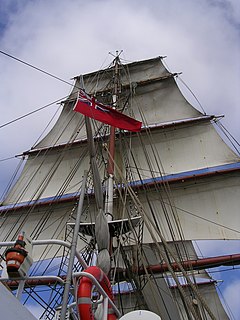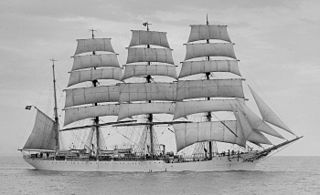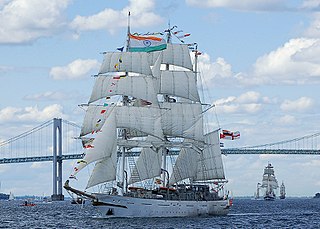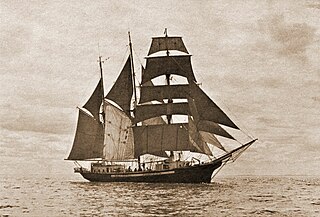
A sail plan is a description of the specific ways that a sailing craft is rigged, as discussed below. Also, the term “sail plan” is a graphic depiction of the arrangement of the sails for a given sailing craft.

A barque, barc, or bark is a type of sailing vessel with three or more masts having the fore- and mainmasts rigged square and only the mizzen rigged fore and aft. Sometimes, the mizzen is only partly fore-and-aft rigged, bearing a square-rigged sail above.

A tall ship is a large, traditionally-rigged sailing vessel. Popular modern tall ship rigs include topsail schooners, brigantines, brigs and barques. "Tall ship" can also be defined more specifically by an organization, such as for a race or festival.

Sail Training International (STI) is an international sail training organisation, with members in 29 countries. Its main aim is to train sailing skills to young people. It is based in Hampshire in the United Kingdom and is a registered charity.

A barquentine or schooner barque is a sailing vessel with three or more masts; with a square rigged foremast and fore-and-aft rigged main, mizzen and any other masts.

Gaff rig is a sailing rig in which the sail is four-cornered, fore-and-aft rigged, controlled at its peak and, usually, its entire head by a spar (pole) called the gaff. Because of the size and shape of the sail, a gaff rig will have running backstays rather than permanent backstays.

Square rig is a generic type of sail and rigging arrangement in which the primary driving sails are carried on horizontal spars which are perpendicular, or square, to the keel of the vessel and to the masts. These spars are called yards and their tips, beyond the last stay, are called the yardarms. A ship mainly rigged so is called a square-rigger.

A fore-and-aft rig is a sailing vessel rigged mainly with sails set along the line of the keel, rather than perpendicular to it as on a square rigged vessel.
A training ship is a ship used to train students as sailors. The term is especially used for ships employed by navies to train future officers. Essentially there are two types: those used for training at sea and old hulks used to house classrooms.

Christian Radich is a Norwegian full-rigged ship, named after a Norwegian shipowner. The vessel was built at Framnæs shipyard in Sandefjord, Norway, and was delivered on 17 June 1937. The owner was The Christian Radich Sail Training Foundation established by a grant from an officer of that name.

Statsraad Lehmkuhl is a three-masted barque rigged sail training vessel owned and operated by the Statsraad Lehmkuhl Foundation. It is based in Bergen, Norway and contracted out for various purposes, including serving as a school ship for the Royal Norwegian Navy.

A jackass-barque, sometimes spelled jackass bark, is a sailing ship with three masts, of which the foremast is square-rigged and the main is partially square-rigged and partially fore-and-aft rigged (course). The mizzen mast is fore-and-aft rigged.

Viking is a four-masted steel barque, built in 1906 by Burmeister & Wain in Copenhagen, Denmark. She is reported to be the biggest sailing ship ever built in Scandinavia. In the 21st century her sailing days have drawn to a close, and she is moored as botel in Gothenburg, Sweden.
Operation Sail refers to a series of sailing events held to celebrate special occasions and features sailing vessels from around the world. Each event is coordinated by Operation Sail, Inc., a non-profit organization established in 1961 by U.S. President John F. Kennedy and must be approved by the United States Congress. Often referred to as OpSail or Op Sail, the event has the goals of promoting good will and cooperation between countries while providing sail training and celebrating maritime history. It is also sometimes erroneously referred to as "Tall Ships". While the tall ships form the centerpiece of the event, smaller sailing vessels also participate.

Juan Sebastián de Elcano is a training ship of the Spanish Navy. It is a four-masted topsail, steel-hulled barquentine. At 113 metres (371 ft) long, it is the third-largest tall ship in the world, and is the sailing vessel that has sailed the furthest, covering more than 2,000,000 nautical miles in its lifetime.

INS Tarangini is a three-masted barque, commissioned in 1997 as a sail training ship for the Indian Navy. She is square rigged on the fore and main masts and fore-and-aft rigged on the mizzen mast. She was constructed in Goa to a design by the British naval architect Colin Mudie, and launched on 1 December 1995. In 2003-04, she became the first Indian naval ship to circumnavigate the globe.

Gustaf Adolf Mauritz Erikson was a ship-owner from Mariehamn, in the Åland islands. He was famous for the fleet of windjammers he operated to the end of his life, mainly on the grain trade from Australia to Europe.

Literally, the word pinisi refers to a type of rigging of Indonesian sailing vessels. A pinisi carries seven to eight sails on two masts, arranged like a gaff-ketch with what is called 'standing gaffs' - i.e., unlike most Western ships using such a rig, the two main sails are not opened by raising the spars they are attached to, but the sails are 'pulled out' like curtains along the gaffs which are fixed at around the centre of the masts.

The sailing ship Regina Maris was originally built as the three-masted topsail schooner Regina in 1908. She was a 144-foot (43.9-meter), wooden, completely fore-and-aft–rigged sailing ship with three masts. She was re-rigged in 1963 as a 148-foot (45.1-meter) barquentine. Regina Maris could reach a speed of up to 12 knots, especially on a half-wind course or with a fresh back-stay breeze.
The following outline is provided as an overview of and topical guide to sailing:

















